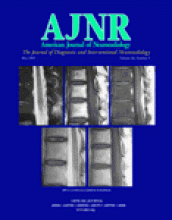Abstract
BACKGROUND AND PURPOSE: Although digital subtraction angiography (DSA) provides excellent visualization of the intracranial vasculature, it has several limitations. Our purpose was to evaluate the ability of helical CT angiography (CTA) to help detect and quantify intracranial stenosis and occlusion compared with DSA and MR angiography (MRA).
METHODS: Twenty-eight patients underwent CTA, DSA, and 3D time-of-flight (TOF) MRA for suspected cerebrovascular lesions. All three studies were performed within a 30-day period. Two readers blinded to prior estimated or calculated stenoses, patient history and clinical information examined 672 vessel segments. Lesions were categorized as normal (0–9%), mild (10–29%), moderate (30–69%), severe (70–99%), or occluded (no flow detected). DSA was the reference standard. Unblinded consensus readings were obtained for all discrepancies.
RESULTS: A total of 115 diseased vessel segments were identified. After consensus interpretation, CTA revealed higher sensitivity than that of MRA for intracranial stenosis (98% versus 70%, P < .001) and occlusion (100% versus 87%, P = .02). CTA had a higher positive predictive value than that of MRA for both stenosis (93% versus 65%, P < .001) and occlusion (100% versus 59%, P < .001). CTA had a high interoperator reliability. In 6 of 28 patients (21%), all 6 with low-flow states in the posterior circulation, CTA was superior to DSA in detection of vessel patency.
CONCLUSION: CTA has a higher sensitivity and positive predictive value than MRA and is recommended over TOF MRA for detection of intracranial stenosis and occlusion. CTA has a high interoperator reliability. CTA is superior to DSA in the evaluation of posterior circulation steno-occlusive disease when slow flow is present. CTA results had a significant effect on patient clinical management.
- Copyright © American Society of Neuroradiology












